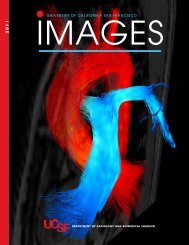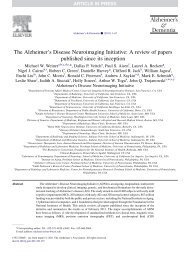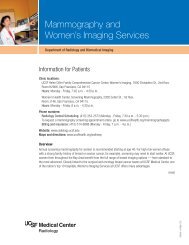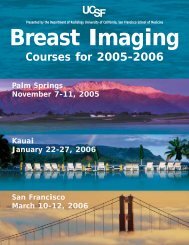6th International Workshop on Breast Densitometry and Breast ...
6th International Workshop on Breast Densitometry and Breast ...
6th International Workshop on Breast Densitometry and Breast ...
- No tags were found...
You also want an ePaper? Increase the reach of your titles
YUMPU automatically turns print PDFs into web optimized ePapers that Google loves.
P37<br />
6 th <str<strong>on</strong>g>Internati<strong>on</strong>al</str<strong>on</strong>g> <str<strong>on</strong>g>Workshop</str<strong>on</strong>g> <strong>on</strong> <strong>Breast</strong> <strong>Densitometry</strong><br />
<strong>and</strong> <strong>Breast</strong> Cancer Risk Assessment<br />
DUAL X-RAY ABSORPTIOMETRY AN ALTERNATIVE METHOD TO MEASURE<br />
VOLUMETRIC BREAST DENSITY<br />
Pereira A 1 , Shepherd J 2 , Garmendia ML 1 , Galleguillos B 1 , Ralph Highnam 3, Uauy R 1 , Corvalán C 1 .<br />
1 Institute of Nutriti<strong>on</strong> <strong>and</strong> Food Technology, University of Chile; 2 Department of Radiology <strong>and</strong><br />
Biomedical Imaging, University of California at San Francisco; 3 Mātakina Technology Limited,<br />
Wellingt<strong>on</strong>, New Zeal<strong>and</strong><br />
Background: Mammographic breast density (BD) is a str<strong>on</strong>g risk factor for breast cancer; however its<br />
use in adolescent populati<strong>on</strong>s is limited due to radiati<strong>on</strong> exposure. Recently, applicati<strong>on</strong>s to measure BD<br />
have been developed for Dual X-Ray Absorptiometry (DXA) systems as a low-dose alternative method. A<br />
previous validati<strong>on</strong> study carried out in ~100 adult women showed a high correlati<strong>on</strong> (r=0.70) between<br />
volumetric breast density (%FGV) measured by DXA <strong>and</strong> area based mammographic BD. Since 2010, we<br />
have followed the mothers of 550 girls participating in the Growth <strong>and</strong> Obesity Chilean Cohort Study to<br />
assess nutriti<strong>on</strong>al determinants of increased BD. In these women, both mammograms <strong>and</strong> DXA scans of<br />
the breasts were obtained. Our aims were i) to determine the precisi<strong>on</strong> of %FGV measured by DXA, <strong>and</strong><br />
ii) to assess the equivalency of %FGV, absolute fibrogl<strong>and</strong>ular volume (AFGV), <strong>and</strong> breast volume (BV)<br />
measures made using DXA <strong>and</strong> mammograms.<br />
Methods: In this cross-secti<strong>on</strong>al study, 126 premenopausal women received both screening digital<br />
mammograms (Hologic Selenia, Bedford, MA, USA) <strong>and</strong> breast DXA scans (GE iDXA, GE healthcare,<br />
Madis<strong>on</strong>, WI). Mammographic “raw” images were used to measure volumetric BD using a fullyautomated<br />
commercial method (Volpara®, Matakina Technology, Wellingt<strong>on</strong>, New Zeal<strong>and</strong>). For the<br />
DXA scans, a left-right-left breast scanning protocol was used. The DXA analysis software was<br />
developed by University of California at San Francisco. The end result was measures of %FGV, AFGV,<br />
<strong>and</strong> BV by both mammography (Mx) <strong>and</strong> DXA. In additi<strong>on</strong>, all women underwent anthropometric<br />
measures (body mass index (BMI)=weight(kg)/height(mt) 2 ) <strong>and</strong> answered a sociodemographic<br />
questi<strong>on</strong>naire. We estimated intraclass correlati<strong>on</strong> coefficient (ICC) <strong>and</strong> the coefficient of variati<strong>on</strong><br />
(precisi<strong>on</strong>) of DXA after repositi<strong>on</strong>ing, c<strong>on</strong>sidering obesity (BMI>30), age (over 36 years) <strong>and</strong> BV (less<br />
than 654 cm 3 ). Using linear regressi<strong>on</strong> models we estimated the correlati<strong>on</strong> coefficient <strong>and</strong> R 2 between<br />
volumetric BD measured with DXA (left image) <strong>and</strong> with Mx (MLO left image).<br />
Results: The mean age was 37.1 years (sd=6.5) <strong>and</strong> 31.6% were obese. Mean time between<br />
mammographic <strong>and</strong> DXA measurements was 9 m<strong>on</strong>ths (sd=5.6). The ICCs for %FGV, AFGV <strong>and</strong> BV<br />
after repositi<strong>on</strong> the left breast were over 0.9 <strong>and</strong> the precisi<strong>on</strong> for %FGV, 3.7%; however the latter<br />
declined to 5% in obese women <strong>and</strong> women with breast volumes less than 654 cm 3 . Mean values for<br />
DXA <strong>and</strong> Mx are shown in Table 1. The correlati<strong>on</strong> coefficients for %FGV, AFGV <strong>and</strong> BV between DXA<br />
<strong>and</strong> Mx were all over 0.8 <strong>and</strong> the R 2 were 0.6, 0.7 <strong>and</strong> 0.8, respectively. The R 2 of %FGV increased to 0.8<br />
if the time between both exams was less than six m<strong>on</strong>ths.<br />
ABSTRACTS<br />
Discussi<strong>on</strong>: DXA is a precise method to measure volumetric BD <strong>and</strong> it correlates better to volumetric<br />
mammography measurements compared to area based models. These results suggest that DXA is a<br />
reliable method to measure volumetric BD that can be used to c<strong>on</strong>tinuously m<strong>on</strong>itor BD in adult women<br />
in follow-up studies<br />
Table 1: Mean <strong>and</strong> st<strong>and</strong>ard deviati<strong>on</strong>(sd) of breast compositi<strong>on</strong> using DXA <strong>and</strong> Mx<br />
<strong>Breast</strong> Compositi<strong>on</strong> Data DXA (mean(sd)) Mx (mean(sd))<br />
%FGV(%) 30.9(10.5) 10.2(5.2)<br />
AFGV(cm 3 ) 214.4(98.8) 67.6(34.7)<br />
BV(cm 3 ) 732.8(315.8 767.9(415.6)<br />
Funding sources: F<strong>on</strong>decyt 3130532 <strong>and</strong> 11100238, WCRF 2010/245 , Ellis<strong>on</strong> Medical Foundati<strong>on</strong> Grant to Ana Pereira<br />
72

















